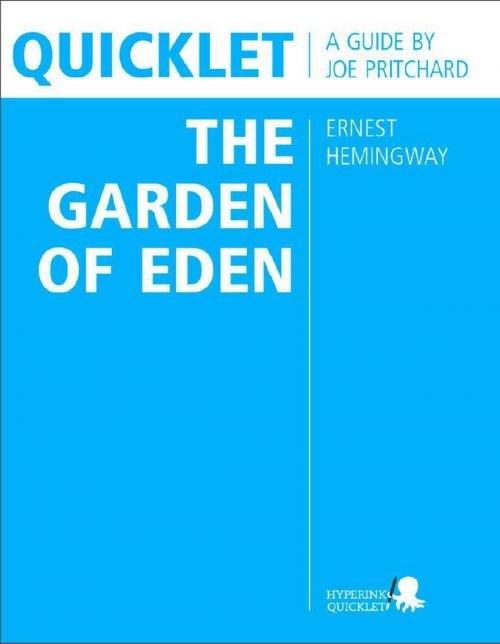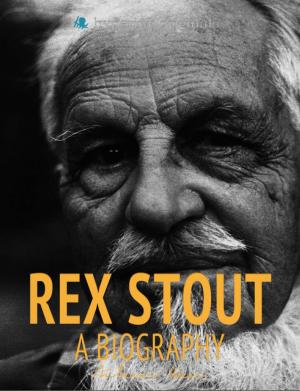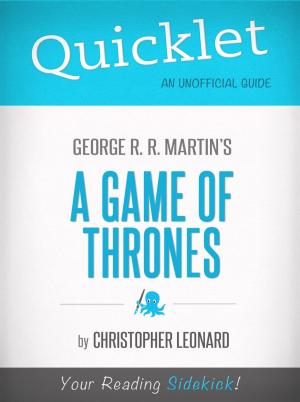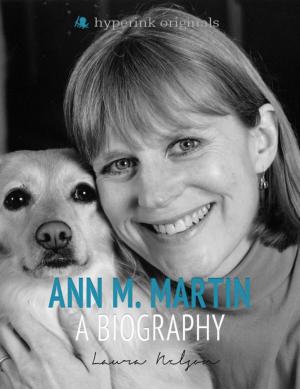Quicklet on Ernest Hemingway's The Garden of Eden
Nonfiction, Reference & Language, Study Aids, Book Notes, Fiction & Literature, Literary Theory & Criticism| Author: | Joseph Phillip Pritchard | ISBN: | 9781614646242 |
| Publisher: | Hyperink | Publication: | July 30, 2012 |
| Imprint: | Hyperink | Language: | English |
| Author: | Joseph Phillip Pritchard |
| ISBN: | 9781614646242 |
| Publisher: | Hyperink |
| Publication: | July 30, 2012 |
| Imprint: | Hyperink |
| Language: | English |
ABOUT THE BOOK
In our youth we are prone to indulging in the idea of love. Young love is primarily concerned with purity, passion, and unconditional care. All too often the immature mind glosses over the more painful moments connected to love and only remembers love as a beautiful force. But as those who have loved and lost will attest, love is rarely the blissful emotion that fairytales make it out to be. Love is messy, and sometimes even dangerous if mixed with some measure of obsession, and a need to control. Such is the case with Ernest Hemingway’s posthumously published classic, The Garden of Eden.
The Garden of Eden was released in the late 1980s, a little over two decades after Ernest Hemingway’s death. The novel’s posthumous publication forced readers and scholars to rethink their perceptions of its author. Early critics of Hemingway often praised his male-centric view of the world. Most of his memorable characters were men performing masculine pursuits. Most of his women were presented as characters that weakened the male protagonist or lead to the deterioration of his life. However, in The Garden of Eden, Hemingway presents two female characters (Catherine and Marita) who are both not molded to fit the “weak” female characters portrayed in Hemingway’s other novels. In fact, Catherine is often presented as more “manly” than her husband. This exploration of gender roles, sexual identity, and sexual deviance drastically deviated from what was expected from Hemingway
The novel also stirred up much criticism about how it was edited. The fact remains that the novel was never finished. This begs the question, how much of it was edited out before finally getting published? Moreover, what other changes would Hemingway have made if he had had the chance to revise his work? Such has always been the problem with posthumously published work. We may never really know what Hemingway’s novel might have turned out to be.
But the material that did make it to print seems to suggest that this piece was something that would have broken new ground for him. Unlike his previous stories, The Garden of Eden didn’t focus on some thrilling, albeit vicarious, adventure. Instead Hemingway ventures into territory that seems more the province of romance novelists than an author of his stature.
Moreover, his two main characters seem to go against type. Perhaps reflective of the story’s role-reversing, gender-bending explorations, Hemingway’s leading male character, David Bourne, is passive, while his lead female, Catherine Bourne, is the one pulling the strings. Those familiar with Hemingway’s previously published novels such as A Farewell to Arms, or For Whom the Bell Tolls will note that while Hemingway has written strong female leads before, he has never really written such relatively timid male characters.
EXCERPT FROM THE BOOK
At this point in the novel some readers are probably wondering to what point and purpose highlighting such an innocuous, and possibly tangential, element could have on the story? Hemingway may have wanted to develop a stronger link between the act of satisfying a physiological need to consume food with the need to satisfy sexual cravings. While this observation is by no means intended to be a Freudian interpretation, it is interesting to note how remarkably similar both types of cravings can be.
More to the point, while crafting a love scene and a scene involving food may seem different, the writing skills needed to be able to engage a reader’s senses are the same for both. Bereft of any visuals, the storyteller must rely purely on the power their words have on the reader’s imagination.
These initial chapters focus on the relationship that exists between the Catherine and David.
ABOUT THE BOOK
In our youth we are prone to indulging in the idea of love. Young love is primarily concerned with purity, passion, and unconditional care. All too often the immature mind glosses over the more painful moments connected to love and only remembers love as a beautiful force. But as those who have loved and lost will attest, love is rarely the blissful emotion that fairytales make it out to be. Love is messy, and sometimes even dangerous if mixed with some measure of obsession, and a need to control. Such is the case with Ernest Hemingway’s posthumously published classic, The Garden of Eden.
The Garden of Eden was released in the late 1980s, a little over two decades after Ernest Hemingway’s death. The novel’s posthumous publication forced readers and scholars to rethink their perceptions of its author. Early critics of Hemingway often praised his male-centric view of the world. Most of his memorable characters were men performing masculine pursuits. Most of his women were presented as characters that weakened the male protagonist or lead to the deterioration of his life. However, in The Garden of Eden, Hemingway presents two female characters (Catherine and Marita) who are both not molded to fit the “weak” female characters portrayed in Hemingway’s other novels. In fact, Catherine is often presented as more “manly” than her husband. This exploration of gender roles, sexual identity, and sexual deviance drastically deviated from what was expected from Hemingway
The novel also stirred up much criticism about how it was edited. The fact remains that the novel was never finished. This begs the question, how much of it was edited out before finally getting published? Moreover, what other changes would Hemingway have made if he had had the chance to revise his work? Such has always been the problem with posthumously published work. We may never really know what Hemingway’s novel might have turned out to be.
But the material that did make it to print seems to suggest that this piece was something that would have broken new ground for him. Unlike his previous stories, The Garden of Eden didn’t focus on some thrilling, albeit vicarious, adventure. Instead Hemingway ventures into territory that seems more the province of romance novelists than an author of his stature.
Moreover, his two main characters seem to go against type. Perhaps reflective of the story’s role-reversing, gender-bending explorations, Hemingway’s leading male character, David Bourne, is passive, while his lead female, Catherine Bourne, is the one pulling the strings. Those familiar with Hemingway’s previously published novels such as A Farewell to Arms, or For Whom the Bell Tolls will note that while Hemingway has written strong female leads before, he has never really written such relatively timid male characters.
EXCERPT FROM THE BOOK
At this point in the novel some readers are probably wondering to what point and purpose highlighting such an innocuous, and possibly tangential, element could have on the story? Hemingway may have wanted to develop a stronger link between the act of satisfying a physiological need to consume food with the need to satisfy sexual cravings. While this observation is by no means intended to be a Freudian interpretation, it is interesting to note how remarkably similar both types of cravings can be.
More to the point, while crafting a love scene and a scene involving food may seem different, the writing skills needed to be able to engage a reader’s senses are the same for both. Bereft of any visuals, the storyteller must rely purely on the power their words have on the reader’s imagination.
These initial chapters focus on the relationship that exists between the Catherine and David.















